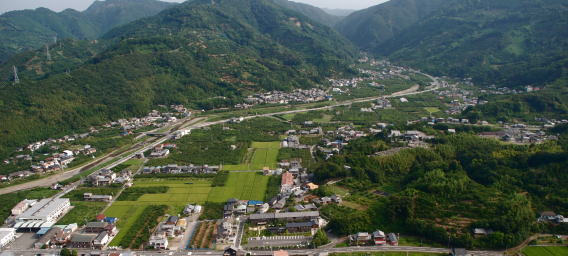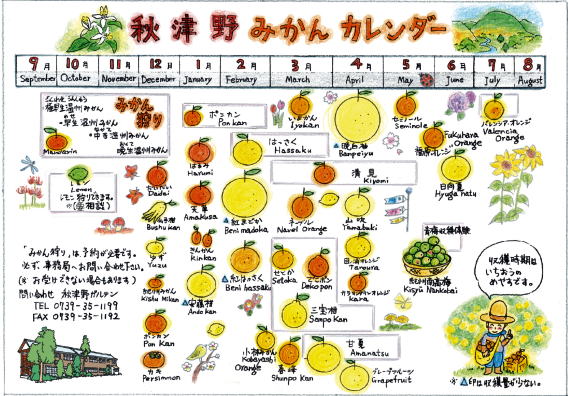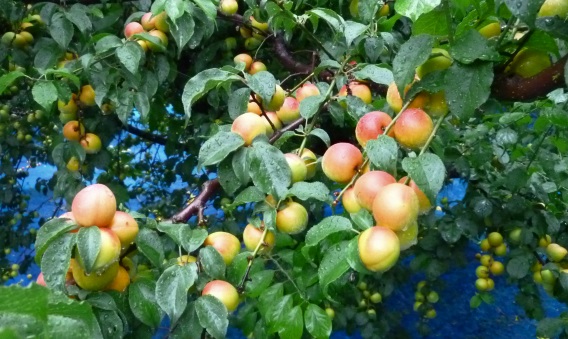Harvesting citrus fruits has prospered since old times.Kamiakizu was a poor neighborhood because of less land for paddy field since it is surrounded by three mountains. It was the end of Edo era to bring the steeply inclined mountain field under cultivation and start harvesting kumquats. Takagi Tomoshichi, a local resident, planted kumquat experimentally and it succeeded in Bunkyu era, and in 1877, clearing mountain forest land in Suginohara for cultivation to plant hundreds of young trees and it expanded into the village. Kumquat is harvested from December to February, and still one of the specialties in Kamiakizu. The cultivation of mikan was begun in the middle of Meiji-era started with small Ko-mikan and Yatsushiro, and after the Pacific War, the cultivations of Unsyu mikan using the slope of the mountain became the mainstream. Making mikan is full of struggle.Getting a baptism of liberalization and repeated sudden falls of mikan price, people raised output of mikan in Kamiakizu and the grove management had developed in 1955’s. Additionally, late-ripening citrus such as Hassaku and Pon-kan were started to be grown many and with that Kamiakizu had become the country of wide variety of mikan. However, in 1965’s, the price of mikan declined precipitously as competition intensifies, and the production adjustment was conducted. In late 1995’s, the word ‘Housaku-binbou’ (impoverishment of farmers because of a bumper harvest) came out and thinning out superfluous fruit was pushed ahead. Besides this, the liberalization of imports of beef, orange, and orange juice threw the grove management in crisis, and reginal agriculture faced a crossroad of existence. Under those circumstances, young farmers found the way out by the effort of introduction of superior kinds. A century has passed since the cultivation started in the area, and now Kamiakizu is one of the representative place of mikan growing district in Wakayama prefecture.Shifting to year-round harvest for the dispersion of riskMikan season is generally from fall to early winter, however, in Kamiakizu, mikan production and shipping continues from winter to spring, and early summer. It is the country of harvesting mikan almost all year. Goku-wase mikan is harvested on late September to early October, and continues to ship in November.On December, Unsyu mikan is the season for harvest and shipping, and it is ripened on the tree in Kamiakizu. On December to February, Iyo-kan and Pon-kan, and toward to spring, Navel Orange, Deko-pon, Kiyomi orange and Hassaku are in season. There is Valencia orange in summer. Famers’ market Kitera which was established in 1999 is well-known to whole country as a direct shop selling mikan all year long. There are more than 80 kinds of mikan harvested in Kamiakizu, from old ones to rare ones. Around Tanabe has the longest hours of sunlight in Japan. Average temperature is about 16.5 degree and annual precipitation is 1650 ml in a year. The warm climate suited for citrus fruits cultivation and the sunshiny land with long hours of sunlight, those advantageous condition of nature brings up mikan in excellent quality.  Any producing districts hasn’t prospered with only one item for thirty years.Next stage with the multiple farming of Mikan and Ume.Ume is the representative specialty of Wakayama prefecture next to Mikan, Tanabe and Minabe is very famous with Ume, and 50 % of it is produced in the area. Processed food of Ume such as Umeboshi is a basic industries in Tanabe and Minabe and crops up the economy of those areas since there are few local industries there. The biggest reason of being Ume district is its kind, Manko Ume. It is a large and fleshy fruit with thin skin and very popular with consumers as “first-class product.” Nanko Ume was born by breed improvement in Minabegawa-mura village in 1945’s, after the war. It spread to Minabe and Tanabe in no time. The history of Nanko Ume cultivation in Kamiakizu is comparatively new. Growing area stayed 37 hectares in 1906’s. The activization began from 1975. It was the time of production (mikan and rice) adjustment, and famers planted Ume trees on the paddy field that doesn’t fit for cultivating Mikan. Nowadays, almost all 300 farmers in the area cultivate Ume, and do multiple farming of Mikan and Ume. There are mainly Nanko Ume and Gojiro Ume used for Ume-syu. Ume is harvested from May to June, and shipped as unripe Ume or Umeboshi by primary processing. Researching to farmers, 40 % of them thinks the best proportion of cultivating Ume and Mikan is four to six or six to four. It shows that they want to strike a good balance between Mikan and Ume and continue the multiple management of mainly Mikan and Ume. Various kinds of citrus fruits are introduced and raised in Kamiakizu, and it is characterized by the country of making mikan all year round. Farmers’ ideas about living in the country of Mikan and Ume won’t change. Those multiple farming has good influences on farmers’ market to have a large selection, and it pulls more customers and contributes to the sales.  |
